
Clean every speck of your lawn with a cordless leaf vacuum –– no extension cords, no outlets, and nothing to hold you back. But what’s the best cordless leaf vacuum for you and your yard? We took the guesswork out of choosing a cordless leaf vacuum by searching Home Depot, Lowe’s, Amazon, and Walmart for the best battery-powered models.
We ranked each vacuum by performance, mulch ratio, comfort, and cost. The leaf vacuums with the best-weighted averages made it to our final list. For more help shopping, check out our buyer’s guide below for tips to help you decide which cordless leaf vacuum will make cleaning up leaves this fall a breeze.
Our Top Picks
| 5 Best Cordless Leaf Vacuums |
| 1. Ryobi RY404150 |
| 2. Greenworks G-Max 24322 |
| 3. Makita XBU04PTV |
| 4. Sun Joe 24V-X2-BVM143 |
| 5. Black + Decker LSWV36 |
Top 5 Cordless Leaf Vacuums – Reviews
1. Ryobi RY404150
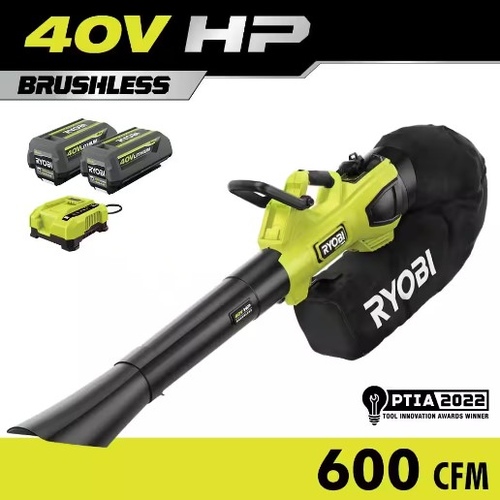
Ryobi RY404150
RYOBI 40V HP Jet Fan Blower/Vacuum: 2X more power, 600 CFM, 100 MPH, mulching, comfortable harness, 2 batteries, rapid charger, 5-year tool warranty.
The Ryobi RY404150 makes yard cleanup simple because it’s potent, versatile, and easy to use:
- Power: Ryobi’s HP technology packs a lot of power into a compact tool. It has a durable brushless motor, advanced electronics, and efficient batteries. Additionally, its jet fan blower and speed tip provide incredible airflow for twice the vacuuming power of previous models.
- Versatility: Its 3-in-1 functionality blows, mulches, and vacuums leaves. It also has variable speed control and an included high-speed tip, making it suitable for lawns, paved services, and flower beds.
- Ease of use: It uses the same tube to blow, vacuum, and mulch, so you can switch modes by simply turning a dial. Additionally, it comes with an adjustable harness for increased comfort and has cruise control for convenience.
And if your city limits how many bags of yard debris they pick, you’ll love how finely the shredder mulches— 20 bags of leaves condense into just 1 bag of mulch.
Specifications
- Airspeed: 100 MPH
- Air volume: 600 CFM
- Battery: 4 Ah, 40 volt
- Motor: Brushless
- Mulch ratio: 20:1
- Noise level: 65 dB
- Warranty: 5 years
- Weight: 15.2 lb.
What’s Included?
The Ryobi RY404150 comes with the following:
- Speed tip
- Adjustable harness
- Lithium-ion batteries (2)
- Rapid Charger (40 min charge time)
- 10.5-gallon collection bag
Pros and Cons
| What we liked | What we didn’t like |
| ✓ Excellent air volume ✓ Excellent mulch ratio ✓ Metal impeller ✓ Well-built motor ✓ Easy to use | ✗ Expensive ✗ Heavy |
2. Greenworks G-Max 24322
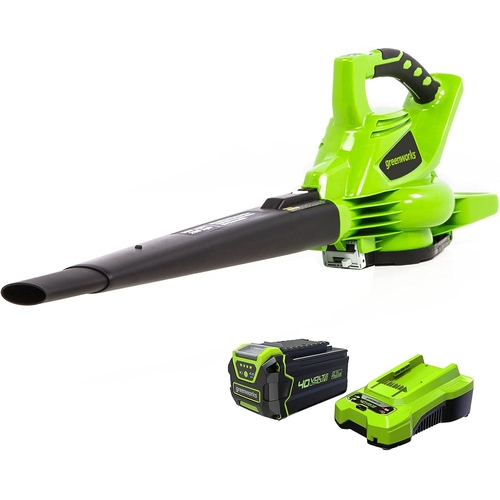
Greenworks G-Max 24322
Powerful 2-in-1 Blower/Vacuum with Brushless Motor, Variable Speed, and 40V System for Efficient Leaf Cleanup. Up to 21 Minutes Runtime.
The Greenworks G-Max handheld leaf blower/vacuum/mulcher uses advanced electric technology, so clearing fallen leaves is a breeze:
- Greenworks’ Intelligent Brushless Motor is digitally controlled for twice the torque and extended motor life.
- The G-MAX battery system is efficient for longer runtimes, shorter charge times, and no post-charging memory loss. Additionally, you can use the same battery system with over 25 Greenworks tools.
- Lightweight: The tool is high-performing but exceptionally light because of Greenworks’ battery and motor efficiency.
The G-Max 24322 also features tool-less conversion between blower and vacuum mode, a variable 6-speed dial, and a turbo button.
Specifications
- Airspeed: 185 MPH
- Air volume: 340 CFM
- Battery: 4 Ah, 40 volt
- Motor: Brushless
- Mulch ratio: 10:1
- Noise level: 80 dB
- Warranty: 3 years
- Weight: 5.6 lb.
What’s Included?
- Leaf Collection Bag
- Lithium-ion battery (1)
- Charger
Pros and Cons
| What we liked | What we didn’t like |
| ✓ Lightweight ✓ Good airspeed ✓ Efficient use of power ✓ Easy to use | ✗ Loud ✗ Wet leaves sometimes clog the mulcher |
3. Makita XBU04PTV
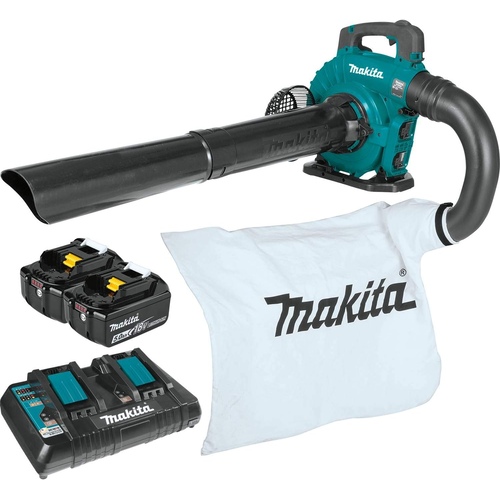
Makita XBU04PTV
3-in-1 Vacuum, Mulcher, and Blower with Makita Brushless Motor: 473 CFM, 120 MPH, 10:1 mulch ratio, precise suction for leaf cleanup.
The Makita XBU04PTV is a handy lawn care helper. It blows, mulches, and vacuums leaves with up to 14 Newtons of blow force. Its strength is due to industry-leading technology, including:
- LXT batteries: Makita’s high-end tools use the LXT battery system. They have longer battery life and faster charge times than standard batteries. They also provide constant power even in very hot or cold weather.
- Star protection: Its electric communication technology prevents overload, over-discharge, and overheating.
- Precision suction: It clears dry leaves without unsettling rocks or stones in garden beds.
The XBU04PTV is packed with all the bells and whistles you expect from a high-end tool, including speed lock, variable speed trigger, cruise control, a shoulder strap, and rubberized soft grips.
Specifications
- Airspeed: 120 MPH
- Air volume: 473 CFM
- Battery: 5 Ah, 18-volt lithium-ion (runs on 2)
- Motor: Brushless
- Mulch ratio: 10:1
- Noise level: 61 dB
- Warranty: 3 years
- Weight: 26.46 lb.
What’s Included?
- Vacuum Attachment Kit
- Lithium-ion batteries (2)
- Rapid Optimum Dual Port Charger
- 3-Stage Telescoping Blower Nozzle
- 1.4-bushel collection bag
Pros and Cons
| What we liked | What we didn’t like |
| ✓ Quiet ✓ Advanced features ✓ Great suction ✓ Ergonomic ✓ Durable construction | ✗ Expensive ✗ Heavy |
4. Sun Joe 24V-X2-BVM143
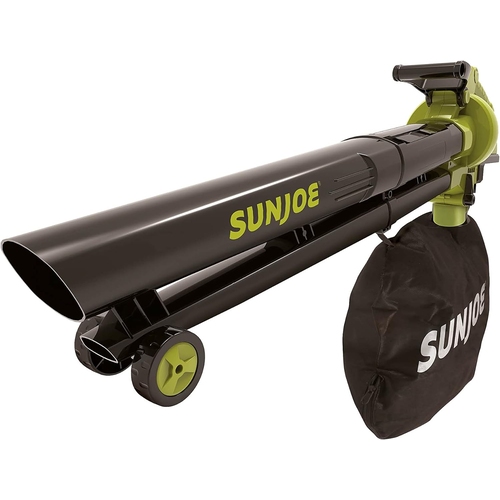
Sun Joe 24V-X2-BVM143
3-in-1 Blower, Vacuum, Mulcher with 9.2-Gallon Bag. Variable Speeds, 8:1 Reduction, Quick Conversion, and 2-Year Warranty. Battery-Powered for Convenience.
The Sun Joe IONMAX 24V-X2-BVM143 is an excellent tool for leaf blowing, vacuuming, and mulching. It’s powerful, easy to use, and eco-friendly, making it great for both small and large yards. It provides convenience, control, and superior performance:
- Convenience: You can switch between blower and vacuum mode in seconds, and it has a push button start.
- Control: Homeowners can easily choose between 5 variable speed settings.
- Performance: Its EcoSharp batteries have high-capacity cells for consistent power. The 24V-X2-BVM143 has a strong blow force and up to 65 minutes of runtime.
With the Sun Joe 24V-X2-BVM143, leaf cleanup is quick and easy.
Specifications
- Airspeed: 163 MPH
- Air volume: 391 CFM
- Battery: 4 Ah, 24-volt lithium-ion (2 included)
- Motor: Brushed
- Mulch ratio: 10:1
- Noise level: 69 dB
- Warranty: 2 years
- Weight: 15.4 lb.
What’s Included?
- Lithium-ion batteries (2)
- 9.2-gallon vacuum bag
Pros and Cons
| What we liked | What we didn’t like |
| ✓ High airspeed ✓ Easy to use ✓ Long runtime | ✗ Heavy ✗ Brushed motor |
5. Black + Decker LSWV36
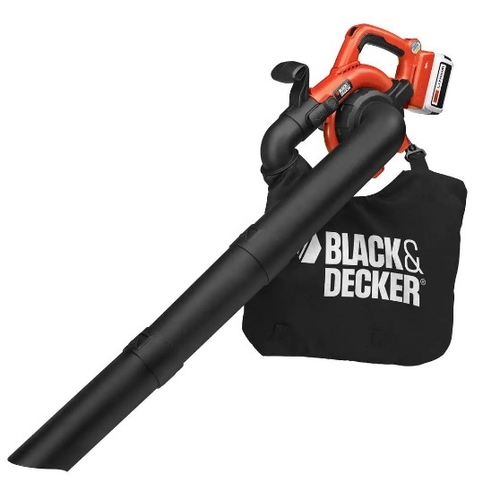
Black + Decker LSWV36
The BLACK+DECKER 40V Sweeper/Vacuum: Effortlessly clear debris from hard surfaces. Converts easily, lightweight, POWERCOMMAND control, built-in scraper, and comfortable grip.
Homeowners on a budget will love the Black + Decker LSWV36 because it’s our list’s lowest-priced leaf vacuum. It includes a sweeper/vacuum kit for clearing leaves off patios, driveways, and decks. The vacuum features:
- An ergonomic design with non-slip soft grips
- POWERCOMMAND adjustable speed control
- Mulching fan
- Blow tube with built-in scraper
It’s an excellent option for townhome owners or anyone looking to clear debris from small to medium-sized paved areas.
Specifications
- Airspeed: 120 MPH
- Air volume: 90 CFM
- Battery: 1.5 Ah, 40-volt
- Motor: Brushed
- Mulch ratio: 6:1
- Noise level: 65 dB
- Warranty: 3 years
- Weight: 6.9 lb.
What’s Included?
- Lithium-ion battery (1)
- Charger
- Vacuum kit
- Collection bag
Pros and Cons
| What we liked | What we didn’t like |
| ✓ Affordable ✓ Lightweight ✓ Great for paved surfaces ✓ Easy to remove debris | ✗ Doesn’t reduce mulch as well as other cordless electric models ✗ Low air volume ✗ Not good for big jobs ✗ Brushed motor |
Buyer’s Guide
To help narrow your decision on the best leaf vacuum for you and your needs, check out our buyer’s guide below to review basic leaf vacuum terms and essential items to consider:
Power Source
Users will often find that a leaf vacuum’s power source significantly impacts their yard work. The three primary power sources are gas, corded electric, and battery. Each power source has its own advantages and disadvantages.
Gas-powered Leaf Vacuums
Gas-powered tools pack lots of power. Equipped with high mph and CFM, gas-powered leaf vacuums typically outperform corded electric and battery-powered equipment. Some gas models even have cruise control. But in some cases, corded electric and battery-powered tools will perform just as well as some gas-powered models.
Commercial operators typically use gas-powered leaf vacuums to handle large projects, though several lower-performing gas leaf vacuums make excellent tools for small yards.
Drawbacks: Despite their exceptional power, gas tools are typically noisy, smelly, and heavy. They can be challenging to turn on and require lots of maintenance. Gas tools also emit exhaust fumes that are harmful to the environment and the user.
Corded Electric Leaf Vacuums
Corded electric leaf blower vacuums need to be plugged into an outlet or extension cord to operate. They are an eco-friendly alternative to gas-powered tools and have an unlimited run time.
Drawbacks: The disadvantage of corded models is that they go only so far. Need to tackle a pile of leaves that’s too far for the extension cord? Then you may need to consider an alternative power source that allows mobility, such as gas or battery-powered.
Battery-powered Leaf Vacuums
If you want to avoid odorous gas tanks, harmful emissions, and limiting extension cords, a battery-powered leaf vacuum may be your best choice. Cordless leaf blower vacuums are eco-friendly and enable user mobility.
Drawbacks: The hassle with battery tools is limited run time and weight. Users can do only so much work before the battery runs out of juice. A battery is also likely to add weight to the leaf vacuum, making the tool heavier than a typical corded model.
Batteries can also be expensive. However, keep in mind that some companies sell batteries that are compatible with several different power tools within the same battery system.
How this can save you money: If you’re already a fan of a particular company, you may already own the battery for a compatible battery-powered leaf vacuum. In this case, you will only need to pay for the tool and not the battery, too.
MPH and CFM
Miles per hour (mph) and cubic feet per minute (CFM) are two essential measures you’ll likely see when shopping for your new leaf vacuum.
What do these two terms mean?
MPH measures how fast the air is moving through the leaf vacuum. If a leaf vacuum has a 250 mph, that means the air sucking up or blowing the leaves is moving at a speed of 250 miles per hour.
CFM measures how much air is moving through the leaf vacuum. If a leaf vacuum has a 350 CFM, that means 350 cubic feet of air is vacuuming or blowing the leaves per minute.
Is one more important than the other?
Both measurements are essential. If one measure is exceptionally high while the other is relatively low, don’t let the higher number fool you.
For instance, if a leaf vacuum has an impressive CFM but a relatively low MPH, the high CFM shouldn’t sell you on the leaf vacuum alone. Because even though the tool may blow or vacuum a high air volume, the air won’t do much to the leaves if it isn’t moving very fast.
The bottom line: MPH measures airspeed, and CFM measures air volume. If power is a priority, it’s best to look for a leaf vacuum with both a good MPH and CFM.
What’s a typical cordless leaf vacuum’s MPH and CFM?
| Average MPH for cordless leaf vacs | 125 |
| Average CFM for cordless leaf vacs | 330 |
| Typical MPH range | 75 – 185 |
| Typical CFM range | 90 – 600 |
Mulch Reduction Ratio
The mulch reduction ratio measures how many bags of leaves a leaf vacuum can shred down to one bag of mulch. For instance, if a leaf vacuum has a mulch ratio of 16:1, that means it can reduce 16 bags of leaves down to one bag of mulch.
If you have a yard with lots of leaves and want to cut down on the number of leaf bags you throw out, you may want to consider a leaf vacuum with a high mulch reduction ratio.
| Average mulch ratio for battery leaf vacs | 13:1 |
| Typical range | 6:1 – 20:1 |
Versatility
Most leaf vacuums have a 3-in-1 tool design as a leaf blower, vacuum, and mulcher. This versatility may prove helpful if you have limited storage space, are shopping on a budget, or prefer an easy transition between tools. All the tools on this list have 3-in-1 functionality, but you can also check out our top picks for the best leaf blower vacuums for other multi-tool options.
Weight
A couple of pounds difference in a leaf vacuum can weigh you down — and wear you down — over time. For this reason, a lighter leaf vacuum may be the better choice.
| Average weight of battery leaf vacs | 12 lb. |
| Typical range | 6 – 25 lb. |
Noise
Leaf vacuums and leaf blowers are noisy. Many counties and cities have local ordinances to limit noise pollution.
Before buying your leaf vacuum, make sure its decibel rating (dBA) is appropriate for your area’s laws. Your neighbors certainly won’t approve of your new leaf vacuum if it’s exceptionally loud and disturbs everyone living on your street.
| Average noise level of battery leaf vacs | 70 dB |
| Typical range | 60 – 80 dB |
Bag Size
Some leaf blowers have larger leaf-collecting bags than others. Keep in mind that the smaller the bag, the more often you’ll need to pause your work to empty it.
FAQ About Cordless Leaf Vacuums
1. Why does my battery-powered leaf vacuum not have the same run time as advertised?
If your leaf vacuum has a shorter run time than you expected, this isn’t always due to a faulty battery. Some advertised run times can be misleading.
A leaf vacuum advertised to have “up to a 60-minute run time” might prove only to have a 60-minute run time when the tool operates at the lowest speed setting. For some users, using a leaf vacuum at its lowest speed to achieve a 60-minute run time may not be suitable for the heavy-duty task at hand.
The bottom line: A leaf vacuum advertised to have a 60-minute run time might have only a 15- or 20-minute run time at the highest speed setting.
To confirm a leaf vacuum’s accurate run time on your desired power setting, check the owner’s manual. This guide will typically outline the different run times at various operating settings.
2. Why get a handheld leaf vacuum instead of a mower leaf vacuum?
Turning an existing lawn mower into a leaf vacuum may prove useful to many operators, but there are some things a handheld leaf vacuum can do that a mower leaf vacuum can’t.
A handheld leaf blower can:
- Suck up leaves on hard surfaces where a mower leaf vacuum can’t, such as the deck, porch, driveway, or walkway.
- Vacuum up leaves on the sides of fences, in tight corners, and other hard-to-reach places a mower leaf vacuum can easily miss.
- Be used indoors. Is lawn debris finding its way into your barn, garage, or tool shed? A handheld leaf vacuum or blower is easy to use indoors, while a mower leaf vacuum is best left for outdoor tasks.
3. How do I get leaves off my gravel?
Worried about sucking up small rocks while trying to vacuum the leaves off your gravel driveway? As long as your leaf vacuum has variable speed control and you use the tool correctly, you won’t vacuum up rocks.
Remember: Leaves weigh less than rocks. Just operate your leaf vacuum at a speed setting strong enough to pick up the leaves but not so strong that it will suck up the rocks, too.
Directions: First, set your leaf vacuum to its lowest setting. Next, try vacuuming a small portion of the gravel area. If the vacuum can pick up the leaves while not disturbing the rocks, the speed level is appropriate to move on to the rest of the rocky area.
Troubleshooting: If the vacuum can’t suck up the leaves, try increasing the speed by one level. Test the increased airflow over a small rock area before moving on to the rest of the leaves. If the vacuum sucks up the rocks even on the lowest level, you may need to buy a leaf vacuum with more adjustable speed settings or a lower mph and CFM.
5. What are the best leaf blowers?
The best cordless leaf blowers include:
- KB Kobalt 630-CFM
- EGO Power+ LB5804
- Toro PowerPlex 51690
The best gas leaf blowers include:
- Schröder SR-6400L
- Poulan Pro PRB26
- Echo ES-250 25.4cc Shred N Vac
When to Call a Leaf Removal Pro
Although the best leaf vacuums simplify yard cleanup, the best way to clear leaves requires no work at all. LawnStarter can connect you with qualified lawn care and landscaping professionals in your area who provide affordable, hassle-free services. The best local leaf removal pros are just a mouse click away.
LawnStarter participates in the Amazon Services LLC Associates Program and other retailer affiliate programs. LawnStarter may earn revenue from products promoted in this article.
Main Image Credit: Orietta Gaspari / Canva Pro / License wih Text Overlay using Canva Pro